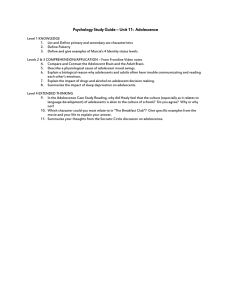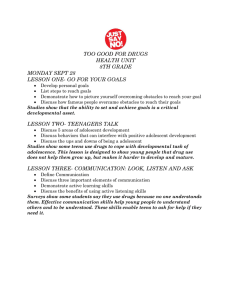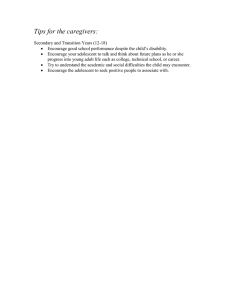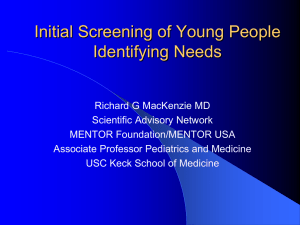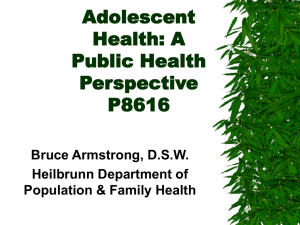Adolescence Development: Physical, Social, Intellectual Changes
advertisement
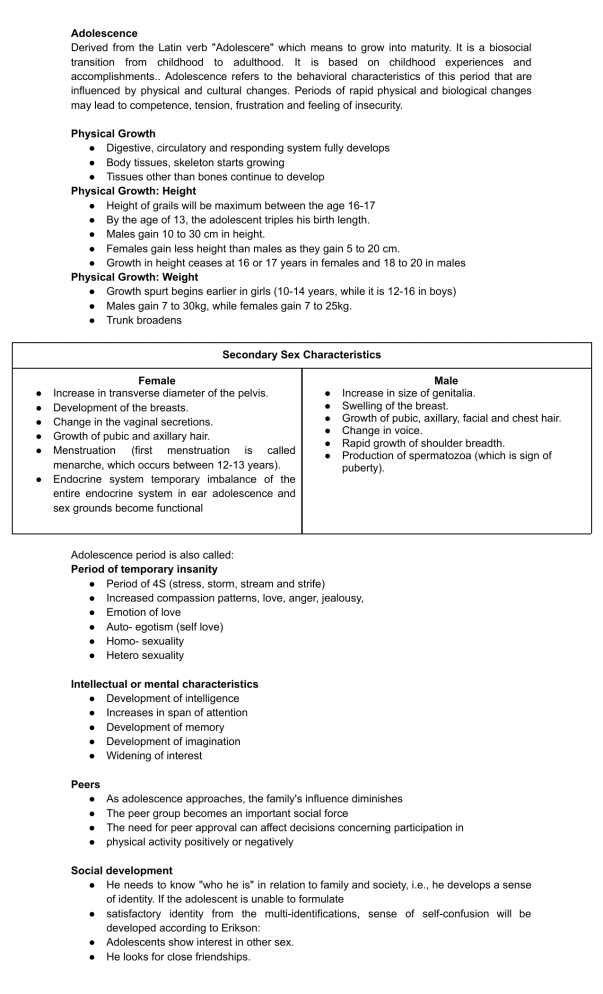
Adolescence Derived from the Latin verb "Adolescere" which means to grow into maturity. It is a biosocial transition from childhood to adulthood. It is based on childhood experiences and accomplishments.. Adolescence refers to the behavioral characteristics of this period that are influenced by physical and cultural changes. Periods of rapid physical and biological changes may lead to competence, tension, frustration and feeling of insecurity. Physical Growth ● Digestive, circulatory and responding system fully develops ● Body tissues, skeleton starts growing ● Tissues other than bones continue to develop Physical Growth: Height ● Height of grails will be maximum between the age 16-17 ● By the age of 13, the adolescent triples his birth length. ● Males gain 10 to 30 cm in height. ● Females gain less height than males as they gain 5 to 20 cm. ● Growth in height ceases at 16 or 17 years in females and 18 to 20 in males Physical Growth: Weight ● Growth spurt begins earlier in girls (10-14 years, while it is 12-16 in boys) ● Males gain 7 to 30kg, while females gain 7 to 25kg. ● Trunk broadens Secondary Sex Characteristics ● ● ● ● ● ● Female Increase in transverse diameter of the pelvis. Development of the breasts. Change in the vaginal secretions. Growth of pubic and axillary hair. Menstruation (first menstruation is called menarche, which occurs between 12-13 years). Endocrine system temporary imbalance of the entire endocrine system in ear adolescence and sex grounds become functional ● ● ● ● ● ● Male Increase in size of genitalia. Swelling of the breast. Growth of pubic, axillary, facial and chest hair. Change in voice. Rapid growth of shoulder breadth. Production of spermatozoa (which is sign of puberty). Adolescence period is also called: Period of temporary insanity ● Period of 4S (stress, storm, stream and strife) ● Increased compassion patterns, love, anger, jealousy, ● Emotion of love ● Auto- egotism (self love) ● Homo- sexuality ● Hetero sexuality Intellectual or mental characteristics ● Development of intelligence ● Increases in span of attention ● Development of memory ● Development of imagination ● Widening of interest Peers ● ● ● ● As adolescence approaches, the family's influence diminishes The peer group becomes an important social force The need for peer approval can affect decisions concerning participation in physical activity positively or negatively Social development ● He needs to know "who he is" in relation to family and society, i.e., he develops a sense of identity. If the adolescent is unable to formulate ● satisfactory identity from the multi-identifications, sense of self-confusion will be developed according to Erikson: ● Adolescents show interest in other sex. ● He looks for close friendships. Developmental tasks that enable adolescents to create an Identity. ● Achieving new and more mature relations with others, both boys and girls, in their age group. ● Achieving a masculine or feminine social role. ● Accepting one's physique ● Achieving emotional independence from parents and other adults ● Preparing for marriage and family life ● Preparing for an economic career. ● Acquiring a set of values and an ethical system as a guide to behavior -developing an ideology. ● Desiring and achieving socially responsible behavior Erik Erikson's Stages of Psychosocial Development: Identity vs. Role Confusion (12-14 years) The fifth stage is identity vs. role confusion, and it occurs during adolescence, from about 12-18 years. During this stage, adolescents search for a sense of self and personal identity, through an intense exploration of personal values, beliefs, and goals. The adolescent mind is essentially a mind or moratorium, a psychosocial stage between childhood and adulthood, and between the morality learned by the child, and the ethics to be developed by the adult (Erikson, 1963, p. 245) This is a major stage of development where the child has to learn the roles he will occupy as an adult. It is during this stage that the adolescent will re-examine his identity and try to find out exactly who he or she is. Erikson suggests that two identities are involved: the sexual and the occupational. Adolescent Developmental stages 1- Early(12-14 years) 2- Middle( 15-17 years) 3-late(>18 years) Central question Am I normal? Who am I? "where do I belong?" where I am going? Major developmental issues ● ● ● ● Coming to terms puberty Struggle for autonomy commence Same sex peer relationships Mood swings ● ● ● ● ● ● New intellectual powers New sexual drives Experimentation and risk-taking Relationships have self-centered quality Need for peer group acceptance Emergence of sexual identity ● ● ● ● ● Independence from parents Realistic body image Acceptance of sexual identity Clear educational and vocational goals, own value system Developing mutually caring and responsible relationship Main Concerns ● ● Anxieties about body shape and changes Comparison with peers ● ● ● ● ● ● Influence of peers Tensions between family and individual over assertions of autonomy Balancing demand of family and peers Prone to fad behavior and risk taking Strong need for privacy Maintaining ethnic identity while striving to fit in with dominant culture ● ● ● Self-responsibility Achieving economic independence Developing intimate relationship. ● ● ● Longer attention span Ability to think more abstractly More able to synthesis information and apply it to themselves Able to think into the future and anticipate consequences of their actions Cognitive Development ● ● ● ● Still fairly concrete thinkers Less able to understand subtlety Daydreaming common Difficulty identifying how their immediate behavior impacts on the future ● ● ● ● Able to think more rationally Concerned about individual freedom and rights Able to accept more responsibility for consequences of own behavior Begin to take on greater responsibility within family as part of cultural identity ● Practice Points ● ● ● ● Reassure about normality Ask more direct than openended questions Base interventions needed on immediate or short-term outcomes Help identify possible adverse outcomes if they continue the undesirable behavior ● ● ● Address confidentiality concerns o Always assess for health risk behavior Focus intervention on short to medium term outcomes. Relate behaviors to immediate physical and social concerns ● ● ● Ask for open- ended questions Focus interventions on short and long term goals Address prevention more broadly Needs of Adolescence 1- Primary or Physiological needs ● oxygen, water, food, rest and sleep ● Rest needs is about 8 hours ● Separate physical education programs 2- Secondary or socio-Psychological needs ● A balance between security and freedom ● Need for love ● Need for approval ● Need for self-expression ● Different types of Co-curricular Activities are needed experiences and utilizing energy ● Sex education on the suitable basis is needed ● Unobtrusive adult guidance is needed ● Need for freedom from dependence ● Need for association with the opposite sex. ● Needs for self support ● Need for philosophy of life Common problem of Adolescence An adolescent is a problem- individual. There are many problems around him and he needs help and guidance for their solution at every step. Excessive energy: In take of food is increased the general health is also improved. Various activities act as sublimation for the adolescent and they feel relieved. With the advent of adolescence the gonads come into activity for the first time. The appearance of secondary sexual characteristics is the same. They produce emotional upheaval in the adolescent. The first appearance of menstrual course or nocturnal emission bewilders and shocks the adolescent who is quite ignorant about it. the school should supply the right kind of information regarding sex at this stage. Due to ignorance about sex, many promising personalities are doomed. Aggressiveness or withdrawal ● When an adolescent can not adjust himself with the world he grows to be aggressive or withdraws from the field and his personality is arrested. If the conflict is too serious he regresses ● The school should provide sample opportunities to the children to express themselves properly. Co curricular activities, scouting students, self-government and changing the methods of instruction can go a long way in enabling the adolescent to adjust himself with the world. Rebellious Attitude ● The adolescents are no longer children. They should be recognized as young men and women in the school as well as in the home. Their craving for independence should be satisfied to some extent. They should be given some responsibility. ● They turn to be very obedient if they are trusted. But things do not work smoothly in ordinary school and home. Their sense of independence and responsibility is seldom recognized. The result is rebellion against authority. Physical awkwardness ● Most adolescents have a sense of physical clumsiness. Consequently their movements stand to be awkward and unbalanced. They may be corrected in the playground and on the stage. Game and dancing will give them harmonious and balanced movement social service at the occasion of festivals etc. practical work can help the children in this respect. Excessive-daydreaming ● Excessive-daydreaming is normal at this stage but when it grows to excessive it may be injurious as far as development of personality is concerned. ● It is the ambition to be free from parental sovereignty. The individual hates control of the parents. He seeks identity for himself. ● The teacher should note that the adolescents are active and busy in their studies and other aspects of their life. ● The children who are indulging in excessive- daydreaming should be encouraged to be constructive and creative. Economic independence ● Money from parents for personal expenses is a major problem. Emotional Tension ● Emotional development is at maximum and unstable. ● Self respect and personal pride make the individual emotionally bad. ● He expects the things to be done as he aspires. Personal appearance ● This is a significant problem. The adolescent is worried about the appearance ● with modern and latest lifestyle at any coast. Morphological/ developmental problem ● Over growth of hair or under growth of hair. ● Overweight and underweight. ● Skin color problems ● Facial deformities, pimples, etc ● Abnormal growth of genital and breast Psychological problems ● Ignorance about many basic facts leads to psychological problems like ● misconception about sexual feeling, sex related issues. ● Misconception about childbirth, reproduction ● Misconception about coitus menstrual cycles. ● Fear about sex and sexual issues. ● Guilt about sex related issues. ● Complex about skin color, abilities, and beauty ● Inexplicable conceptions about dress and fashion codes. ● Wrong and unrealistic ideologies about friendship and courtship ● Attraction towards opposite sex ● Exceptional vulnerability to suicide psychology. Social ● Intense closeness with brother, sister and friends. ● Unpredictable and volatile relationship with friend ● Unrealistic social perception about violence, sex, love as influenced by the media. ● Fear/ imagination about marriage life Educational ● Tension of attending the classes, examination and test. ● Low IQ feeling ● Fear about failure in examination ● Fear about low score ● Worry about future career ● Misconception about teachers. Causes of Emotional Disturbance ● Main causes intense self-consciousness, strong feelings of inferiority, unhappy relation with parents, disgust or fear of first experience of sex emotion. ● Change of the roles of the adolescent at home, school, society, from dependence to independent life with great responsibility leads to emotional disturbance. Attitude of parents( still leading them as children high expectation of parents, community and society) ● Difficulty adjusting with members of the opposite sex. References https://basics.nami.org/docs/simplypsychology.org-Erik-Erikson.pdf https://oercommons.org/courseware/lesson/66171/overview?fbclid=IwAR2QsqXg-jn5e2lw_KEO A1we13Jy15xu6LIQTWCNbFCUQjzEYlkO3C8HTz8 https://byjus.com/question-answer/what-are-5-characteristics-of-adolescence/?fbclid=IwAR2Br3 sEgsgaMbrX70mMwPV3WUveduH7y8p9Rbii1_snBY5s8-V2hhVsaro
